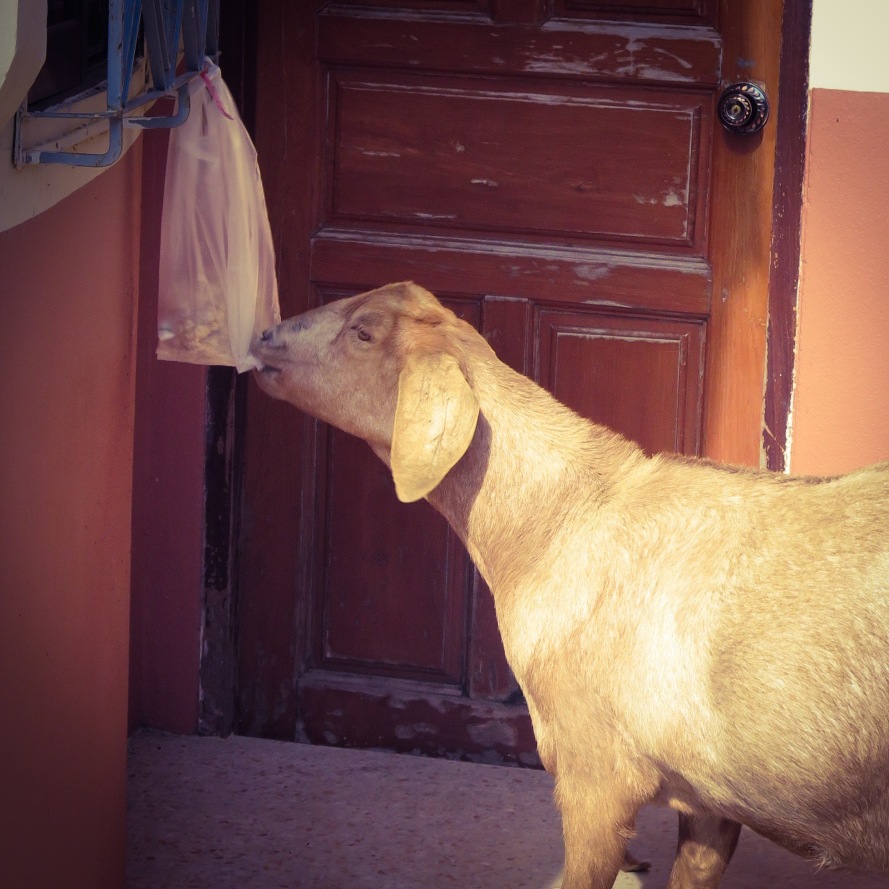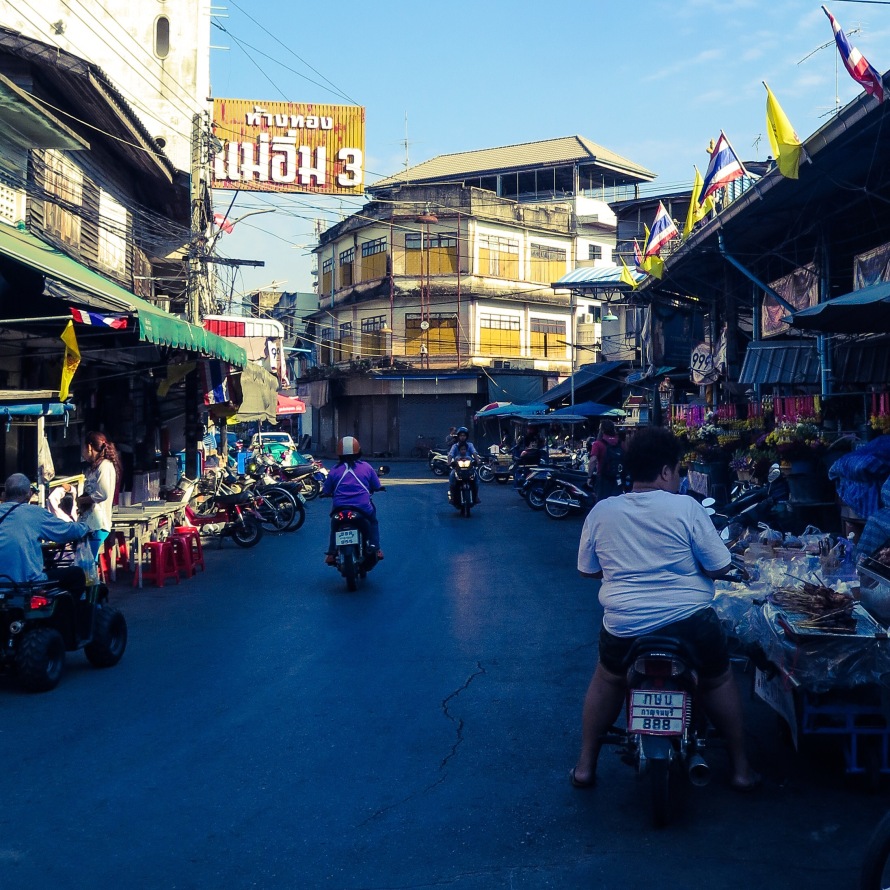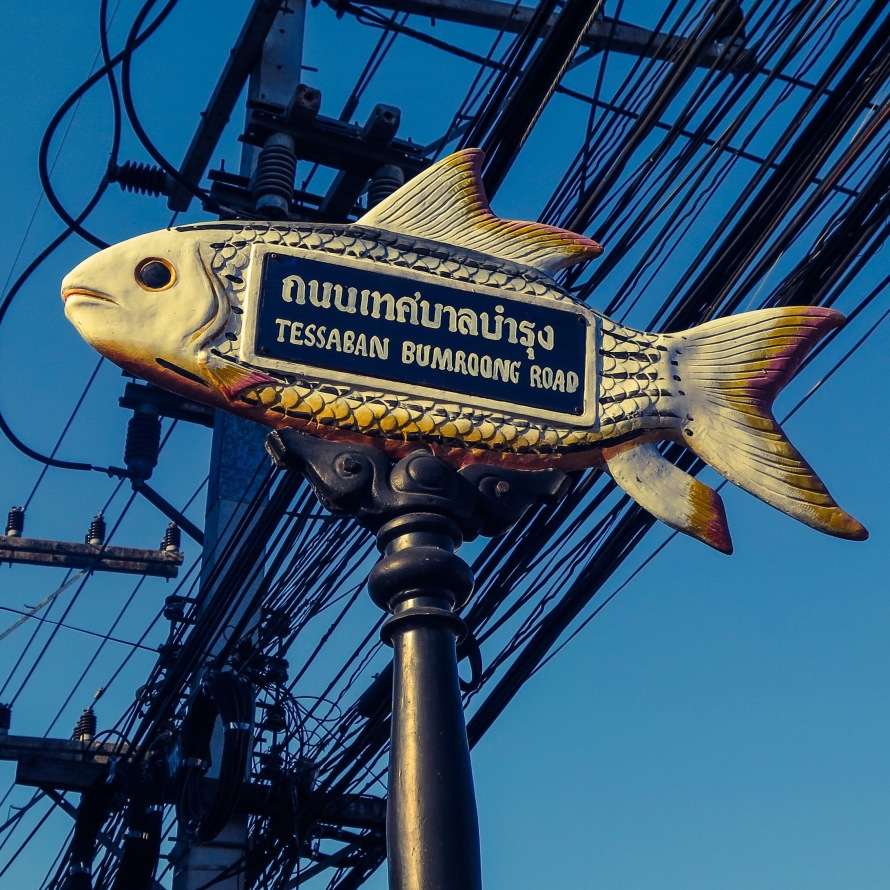There are an awful lot of decent photos in this one, and I have had many large beers, and we have an early train in the morning…so I’m gonna let the pictures do a lot of the talking in this one. It’s best for everyone really. I’m sure that you’ll all understand.
Leaving Bangkok, Bex and I turned our attention to the Thai countryside and the history of Kanchanaburi, known most recently for its contribution to the story of the Pacific theater of World War II. Kanchanaburi is very near to the location of the fictional-but-based-on-actual-events story told in the classic film Bridge on the River Kwai.
If you have not seen that film, I urge you to pause right now and put it on your list of movies to watch. Obi Wan Kenobi and William Holden are both in it, and pretty much everyone who understands film considers it a must-see.
We reached this place by train. That took a few hours, but it was a breezy, beautiful day in Thailand, and the ride was fascinating. There was a brief altercation that we witnessed as we arrived at the train station, between a thirty-something guy (accompanied by his grandmother) and an old woman. It went on for about ten minutes. I have no idea what it was about. The security guys were surprisingly slow to get involved, and surprisingly timid in their response. In the US, the dude would have gone to jail. It was an interesting situation to witness. Hope it all got worked out.
After I finished gawking at that situation, I bought a cold Coke and we waited for our train. One of many nice things about Thailand is that they appreciate the value of a cold drink (I’m talking to you, Peru).
 The train that brought us from Bangkok to Kanchanburi. We witnessed some near-violence between the locals at the train station.
The train that brought us from Bangkok to Kanchanburi. We witnessed some near-violence between the locals at the train station.
 The sights along the way on our three-hour journey to Kanchanaburi were interesting.
The sights along the way on our three-hour journey to Kanchanaburi were interesting.
 Here’s four…no wait, *five*…very close friends on a small scooter. This sort of togetherness is a common site in Thailand. We have been terrified several times to see a baby jammed between two parents on a scooter and zooming down the road.
Here’s four…no wait, *five*…very close friends on a small scooter. This sort of togetherness is a common site in Thailand. We have been terrified several times to see a baby jammed between two parents on a scooter and zooming down the road.
 A peak right off the patio of our floating “raft” room. That’s the Kwai River.
A peak right off the patio of our floating “raft” room. That’s the Kwai River.
 Sunset on our first afternoon in Kanchanaburi.
Sunset on our first afternoon in Kanchanaburi.
Kanchanaburi has a very different vibe than Bangkok. Bangkok is the size of Chicago, in terms of people and sprawl. Kanchanaburi is a country town of 30,000.
As noted earlier, this place is most significant for its unfortunate association with the Japanese occupation during World War II, and the related war crimes that occurred in this area, due to the desire by the Japanese to construct a railroad supply line between Japan and Burma (now known as Myanmar).
This supply line was needed to fortify Japan’s efforts during the war. Japan was at this time in the midst of a major expansionist effort, very analogous to Germany’s. Japan’s conquests included parts of western China and lots of southeast Asia. Japanese ambition for conquest rivaled that of Germany. Thailand and other southeastern Asian territories were lands (and peoples) to be conquered and assimilated.
The supply railway was considered essential to the war effort, and slave labor in the form of POW’s and Asian conscripted laborers was employed. Equipment was insufficient; timelines were unrealistic; conditions were poor; workers were cruelly mistreated.
The Burma Railway, also known as the Death Railway, the Burma-Siam Railway, the Thailand–Burma Railway and similar names, was a 415 kilometers railway between Ban Pong, Thailand, and Thanbyuzayat Burma. This railway completed the railroad link between Bangkok, Thailand and Rangoon, Burma (now Yangon). The line was closed in 1947, but the section between Nong Pla Duk and Nam Tok was reopened in 1957.
More than 180,000 Asian civilian labourers and 60,000 Allied POWs worked on the railway. Of these, probably about 90,000 Asian workers died due to the working conditions. 12,621 Allied POWs died during the construction. The dead POWs included 6,904 British personnel, 2,802 Australians, 2,782 Dutch, and 133 Americans.
After the end of World War II, 111 Japanese and Koreans were tried for war crimes because of their brutalization of POWs during the construction of the railway. 32 were sentenced to death.
 A graveyard for POW’s who perished near Kanchanaburi, building the Japanese railway to Burma. The Japanese often treated these prisoners cruelly, but afforded them all proper burials. Each grave is marked with the name, rank, date of death, and age of each soldier who perished here.
A graveyard for POW’s who perished near Kanchanaburi, building the Japanese railway to Burma. The Japanese often treated these prisoners cruelly, but afforded them all proper burials. Each grave is marked with the name, rank, date of death, and age of each soldier who perished here.
 Chedis (literally “mounds”) in a Thai graveyard next to the POW graveyard.
Chedis (literally “mounds”) in a Thai graveyard next to the POW graveyard.
 The POW graves in Kanchanaburi are immaculately manicured. There were at least half a dozen groundskeepers working dilligently at the time that we visited. Each grave marker has its own beautiful, manicured flowering plant. Although the grave markers are uniform in size and appearance, and precisely spaced, most have a quote specific to the soldier memorialized. It is a beautiful but profoundly tragic place.
The POW graves in Kanchanaburi are immaculately manicured. There were at least half a dozen groundskeepers working dilligently at the time that we visited. Each grave marker has its own beautiful, manicured flowering plant. Although the grave markers are uniform in size and appearance, and precisely spaced, most have a quote specific to the soldier memorialized. It is a beautiful but profoundly tragic place.
The Death Railway museum is located next to the POW graveyard. We visited both. The museum is small, but is full of remarkable, moving information, including a short documentary film, as well as letters and personal effects of some of the prisoners who were here. The letters from home, and illustrations created by the prisoners during their captivity, are emotionally devastating.
Even more moving is the graveyard. I didn’t want to cry, but I lost it a few times while walking through the grounds and reading the headstones. Each marker represents so much…a man, a life, a family, a legacy…affected, disrupted, scarred, tortured…for generations…by the heroic, honorable, unnecessary, cruel death of a person. As we walked through these grounds, we read some of the thousands of markers. They grounds and the graves are immaculately kept. Many of the grave markers contained a personalized message to the dead, selected by family and friends.
Our beloved and cherished son. We love you and will remember you every day…
There is a small corner of England here, always, in this field…
I’m so sorry we couldn’t be with you to say goodbye…
I thought of my own sons.
We walked on.
We saw a Buddhist temple complex, and we wandered in. I know nothing of it, other than what we saw. It was large, ornately decorated, and contained at least one goat. Enjoy some pictures:
 This goat was wandering the grounds of an ornate Buddhist temple complex that we stumbled upon during a walk around Kanchanaburi. Based on what I’ve observed here and in Norway, goats will in fact eat anything. A few moments after this photo was taken, a Thai woman came and attempted to shoo the goat away from this bag of whatever that is. The goat was largely unmoved, despite the short sharp shock of her reprimand.
This goat was wandering the grounds of an ornate Buddhist temple complex that we stumbled upon during a walk around Kanchanaburi. Based on what I’ve observed here and in Norway, goats will in fact eat anything. A few moments after this photo was taken, a Thai woman came and attempted to shoo the goat away from this bag of whatever that is. The goat was largely unmoved, despite the short sharp shock of her reprimand.
 Happy Buddha on the grounds of the temple complex that we encountered.
Happy Buddha on the grounds of the temple complex that we encountered.
 Have we mentioned that there is no shortage of golden Buddhas in Thailand? Have we mentioned that Buddhism is the only religion that comes to mind in which its proponents don’t kill the folks from the other religions?
Have we mentioned that there is no shortage of golden Buddhas in Thailand? Have we mentioned that Buddhism is the only religion that comes to mind in which its proponents don’t kill the folks from the other religions?
 It’s Buddha, and he is covered with Chrysanthemums, and he has hair, but I don’t know why. Maybe one of you does. I have a lot of learning to do to get up to an appropriate speed on Buddhism. I’ll work on it.
It’s Buddha, and he is covered with Chrysanthemums, and he has hair, but I don’t know why. Maybe one of you does. I have a lot of learning to do to get up to an appropriate speed on Buddhism. I’ll work on it.
 The rarely seen cat-on-a-leash. Generally, cats lose their bones and become an inanimate bag of warm, furry goo when a leash is attached. This guy, however, seems cool with it.
The rarely seen cat-on-a-leash. Generally, cats lose their bones and become an inanimate bag of warm, furry goo when a leash is attached. This guy, however, seems cool with it.
 The streets of Kanchanaburi. Its so simple, but I love walking (and running) the streets of these unknown places. Walking them is how they become known.
The streets of Kanchanaburi. Its so simple, but I love walking (and running) the streets of these unknown places. Walking them is how they become known.
 More of the beautiful Buddhist temple grounds.
More of the beautiful Buddhist temple grounds.
 This tree and several like it were seen on the temple grounds. It looks like the lower root system was once encased on some sort of container or retaining wall.
This tree and several like it were seen on the temple grounds. It looks like the lower root system was once encased on some sort of container or retaining wall.
 Fish signage abounds in Kanchanaburi.
Fish signage abounds in Kanchanaburi.
 Street puppies. Irresistible, fat, warm street puppies. If we didn’t live on another continent, I’m sure we would have adopted this guy or one of his siblings.
Street puppies. Irresistible, fat, warm street puppies. If we didn’t live on another continent, I’m sure we would have adopted this guy or one of his siblings.
 Yet more fish-oriented signage.
Yet more fish-oriented signage.
 Squid on a stick. Not (yet) attempted. I told Bex that I would do it if she will. So its on her…
Squid on a stick. Not (yet) attempted. I told Bex that I would do it if she will. So its on her…
 Street vendor fried chicken. Also, the best fried chicken that I have ever had. I went back for seconds.
Street vendor fried chicken. Also, the best fried chicken that I have ever had. I went back for seconds.
 The noodles that accompanied the chicken. We made a friend during this meal.
The noodles that accompanied the chicken. We made a friend during this meal.
 Big ole street market in downtown Kanchanaburi. I’ve been surprised at how much the Thai people seem to enjoy a good market. I bought an awesome “Ride Like Hell” belt buckle here for two dollars.
Big ole street market in downtown Kanchanaburi. I’ve been surprised at how much the Thai people seem to enjoy a good market. I bought an awesome “Ride Like Hell” belt buckle here for two dollars.
Tomorrow: We visit the actual bridge on the River Kwai, and other real historical sites. Tune in….same bit-time, same bat-channel. Cheers!


Wow. Your pictures of my town are so beautiful. I hope you had a great time in my little town of Kanchanaburi.
We had a wonderful time! Very peaceful after Bangkok. We hope to be back some day!
Reblogged this on Chocdee T-shirts and commented:
I really love this blogger’s photos and travel story of Kanchanaburi. I thought I would share it with you.
Chocdee!
Thanks for the feature! We love beautiful Thailand and can’t wait to come back.
You’re welcome. Any time.